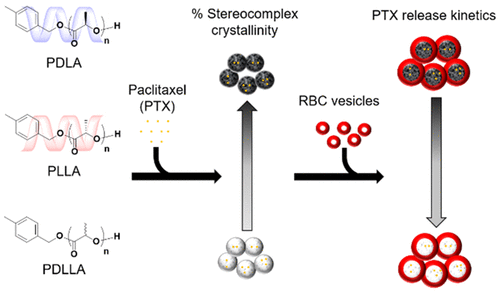当前位置:
X-MOL 学术
›
ACS Mater. Lett.
›
论文详情
Our official English website, www.x-mol.net, welcomes your
feedback! (Note: you will need to create a separate account there.)
Erythrocyte-Membrane-Camouflaged Nanocarriers with Tunable Paclitaxel Release Kinetics via Macromolecular Stereocomplexation
ACS Materials Letters ( IF 9.6 ) Pub Date : 2020-04-30 , DOI: 10.1021/acsmaterialslett.0c00044 Yen-Nan Lin 1, 2 , Mahmoud Elsabahy 1, 3, 4 , Sarosh Khan 1 , Fuwu Zhang 1 , Yue Song 1 , Mei Dong 1 , Richen Li 1 , Justin Smolen 1 , Rachel A. Letteri 5 , Lu Su 6 , Karen L. Wooley 1
ACS Materials Letters ( IF 9.6 ) Pub Date : 2020-04-30 , DOI: 10.1021/acsmaterialslett.0c00044 Yen-Nan Lin 1, 2 , Mahmoud Elsabahy 1, 3, 4 , Sarosh Khan 1 , Fuwu Zhang 1 , Yue Song 1 , Mei Dong 1 , Richen Li 1 , Justin Smolen 1 , Rachel A. Letteri 5 , Lu Su 6 , Karen L. Wooley 1
Affiliation

|
Biomimetic-cell-membrane-camouflaged polymeric nanocarriers, possessing advantages related to the functional diversity of natural cell membranes and the physicochemical tailorability of synthetic polymers, serve as promising candidates for a therapeutic platform. Herein, we report a facile approach for the fabrication of erythrocyte (red blood cell, RBC)-membrane-camouflaged nanocarriers (RBC-MCNs) that exhibit tunable paclitaxel (PTX) release kinetics via altering macromolecular stereostructure. In this approach, biocompatible isotactic and atactic polylactides (PLAs) with similar molar masses (Mn = 8.2–8.9 kDa, as measured by NMR spectroscopy) and dispersities (Đ < 1.1, as measured by size exclusion chromatography) were synthesized via organocatalyzed ring-opening polymerizations (ROPs), providing tunable crystalline structures via polymer tacticity, while RBC membranes provided biomimetic surfaces and improved colloidal stability of PLA nanoconstructs in phosphate-buffered saline (PBS, pH 7.4). Wide-angle X-ray diffraction (WAXD) and differential scanning calorimetry (DSC) analyses of the lyophilized nanoconstructs suggested significant retention of PLA stereocomplexation upon loading the hydrophobic anticancer drug PTX, enabling control over drug release kinetics. The structure–property relationships were maintained after the RBC coating, with 100% stereocomplexed PLA RBC-MCNs exhibiting the least PTX release during the first 12 h in PBS at 37 °C, compared to 2-, 3-, and 4-fold higher amounts of release for the 50% stereocomplexed, isotactic, and amorphous PLA counterparts, respectively. The extended release of PTX from the 100% stereocomplexed PLA RBC-MCNs resulted in an increased IC50 (0.50 μM) against SJSA osteosarcoma cells, relative to amorphous PLA RBC-MCNs (IC50 = 0.25 μM) or free PTX (IC50 = 0.05 μM). In contrast, non-PTX-loaded RBC-MCNs were not cytotoxic, and they also displayed lower immunotoxic responses against RAW 264.7 macrophage cells compared to RBC membrane vesicles. This work represents fundamental advances toward a potential personalized nanocarrier technology that would be capable of employing an individual’s RBCs for membrane isolation, together with tuning of cargo loading and release simply via alteration of the biocompatible PLA stereoisomer feed ratio.
中文翻译:

可调节紫杉醇通过大分子立体复合释放动力学的红细胞-膜伪装的纳米载体。
仿生细胞膜伪装的聚合物纳米载体具有与天然细胞膜的功能多样性和合成聚合物的理化适应性相关的优势,可作为治疗平台的有希望的候选者。在这里,我们报告的一种简便的方法来制造红血球(红细胞,RBC)-膜伪装的纳米载体(RBC-MCNs),通过改变大分子立体结构展示紫杉醇(PTX)的释放动力学。在这种方法中,具有相似的摩尔质量(M n = 8.2–8.9 kDa,通过NMR光谱法测量)的生物相容性等规和无规聚丙交酯(PLA )和分散度(Đ通过有机催化的开环聚合(ROP)合成了<1.1,通过尺寸排阻色谱法测量),通过聚合物的立构规整度提供了可调节的晶体结构,而RBC膜提供了仿生表面,并改善了磷酸盐缓冲盐水(PBS)中PLA纳米结构的胶体稳定性,pH 7.4)。冻干的纳米结构的广角X射线衍射(WAXD)和差示扫描量热法(DSC)分析表明,加载疏水性抗癌药PTX后,PLA立体复合体显着保留,从而可以控制药物释放动力学。在RBC涂层后,保持了结构与性质的关系,与2-,3-,和50%立体复合,等规和无定形PLA对应物的释放量分别提高了4倍。PTX从100%立体复合的PLA RBC-MCN的延长释放导致IC增加相对于无定形PLA RBC-MCNs(IC 50 = 0.25μM)或游离PTX(IC 50 = 0.05μM ),抗SJSA骨肉瘤细胞50(0.50μM )。相反,未加载PTX的RBC-MCN没有细胞毒性,并且与RBC膜囊泡相比,它们对RAW 264.7巨噬细胞的免疫毒性反应也较低。这项工作代表了潜在的个性化纳米载体技术的根本进步,该技术将能够利用个人的RBC进行膜分离,并通过改变生物相容性PLA立体异构体的进料比例来调节货物的装载和释放。
更新日期:2020-04-30
中文翻译:

可调节紫杉醇通过大分子立体复合释放动力学的红细胞-膜伪装的纳米载体。
仿生细胞膜伪装的聚合物纳米载体具有与天然细胞膜的功能多样性和合成聚合物的理化适应性相关的优势,可作为治疗平台的有希望的候选者。在这里,我们报告的一种简便的方法来制造红血球(红细胞,RBC)-膜伪装的纳米载体(RBC-MCNs),通过改变大分子立体结构展示紫杉醇(PTX)的释放动力学。在这种方法中,具有相似的摩尔质量(M n = 8.2–8.9 kDa,通过NMR光谱法测量)的生物相容性等规和无规聚丙交酯(PLA )和分散度(Đ通过有机催化的开环聚合(ROP)合成了<1.1,通过尺寸排阻色谱法测量),通过聚合物的立构规整度提供了可调节的晶体结构,而RBC膜提供了仿生表面,并改善了磷酸盐缓冲盐水(PBS)中PLA纳米结构的胶体稳定性,pH 7.4)。冻干的纳米结构的广角X射线衍射(WAXD)和差示扫描量热法(DSC)分析表明,加载疏水性抗癌药PTX后,PLA立体复合体显着保留,从而可以控制药物释放动力学。在RBC涂层后,保持了结构与性质的关系,与2-,3-,和50%立体复合,等规和无定形PLA对应物的释放量分别提高了4倍。PTX从100%立体复合的PLA RBC-MCN的延长释放导致IC增加相对于无定形PLA RBC-MCNs(IC 50 = 0.25μM)或游离PTX(IC 50 = 0.05μM ),抗SJSA骨肉瘤细胞50(0.50μM )。相反,未加载PTX的RBC-MCN没有细胞毒性,并且与RBC膜囊泡相比,它们对RAW 264.7巨噬细胞的免疫毒性反应也较低。这项工作代表了潜在的个性化纳米载体技术的根本进步,该技术将能够利用个人的RBC进行膜分离,并通过改变生物相容性PLA立体异构体的进料比例来调节货物的装载和释放。







































 京公网安备 11010802027423号
京公网安备 11010802027423号